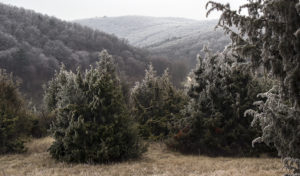General description of project area
Name of the project area: Koloska
Surface area (ha): 54.140
EU protection status SPA: –
EU protection status SCI: NATURA 2000 Code HUBF 20034
Other protection status according to national or regional legislation: National Park
The main uses of the project site: The main land uses: Nature Conservation 50%, tourism 10%, forestry 40%
The ownership status: Sate property 100%

Scientific description of project area
The Koloska valley is a warm narrow valley in the southern part of the Balaton Upland. The valley is running from the north to south. The bedrock is limestone and dolomite. There are 91G0 * Pannonic woods with Quercus petraea and Carpinus betulus forests (35%) at the bottom of the valley. There are 91H0* Pannonian woods with Quercus pubescens (35%) and 91M0 Pannonian-Balkanic turkey oak –sessile oak forests (29%) on the slopes. There are rocks on the hilltops and at some places alien Pinus nigra was planted on the 91H0* Pannonian woods with Quercus pubescens forest. In those parts that are suitable for forestry there are 2-6 ha size homogeneous blocks today where the wood stock was reduced by previous forestry activity.
Characteristic plants are: Coronilla vaginalis, Limodorum abortivum, Pyrus nivalis,
Characteristic animals are:
- Mammals: Myotis blythii, Myotis myotis
- Birds: Dendrocopos medius, Dendrocopos minor, Dryocopus martius, Picus canus, Picus viridis
- Insect: Callimorpha quadripunctaria, Cerambyx cerdo, Eriogaster catax, Lucanus cervus,
Importance of the project area for biodiversity and/or for the conservation of the species /habitat types targeted at regional, national and EU level
The project area is a very important for the rehabilitation of the 91G0 * Pannonic woods with Quercus petraea and Carpinus betulus and 91H0* Pannonian woods with Quercus pubescens habitat which is an EU priority habitat according to Annex I. of the Habitat Directives. The forests need rehabilitation especially in those parts which became homogeneous due to former forestry activities.
The restoration of the area will be an example in the region for other forest managers.
Flagship species in project area
Hippocrepis emerus, Ficedula albicollis, Barbastella barbastellus